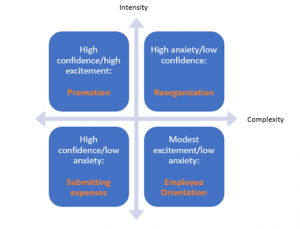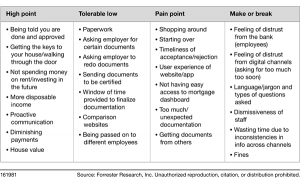Build A Culture Of Emotionally Intelligent Employees To Boost Mental Health
Many companies get emotion wrong …
Rather than designing experiences built on a broad spectrum of emotions, they equate emotion with delight. But real joy and real happiness can only exist in relation to all the emotions — they are a “boxed set.” We cannot just pick and choose our emotions. Anger isn’t joy, just as joy isn’t contentment, just as accepted is not respected. Emotions are information. Anger sets your boundaries. Anger’s basic message is one of protection. Confusion tries to protect you by halting your actions. Sadness helps you slow down. Happiness holds our sense of wonder and anticipation of good things, and it looks forward to the future. Each of our emotions has its own individual message and purpose. Emotions help us to navigate our way through life.
Emotion also drives business results. It is the primary driver of customer loyalty. It accounts for nearly half of a brand’s energy (brand energy gets charged by emotion, salience, and fit — overwhelmingly, emotion forms the most important pillar). Emotions in the workplace influence everything from leadership effectiveness to building and maintaining complex relationships, from innovation to employee and customer interactions. When we acknowledge, honour, and learn to work with our emotions in ingenious ways, we improve the quality of our relationships and our mental health.
Emotions influence how people decide, think, and work toward their goals. Developing emotional intelligence and creating an emotionally intelligent ecosystem helps us more accurately identify our own and others’ emotions while at work. It’s critical to match the emotion to the task at hand. A confident vibe might be great for encouraging creative ideas during a brainstorm but not so helpful for the creation of detailed, accurate product plans. Many employees report feeling stressed, frustrated, and overwhelmed. Emotional skills help us foster successful workplaces, where mental health is a priority.
So why do we spend so little time understanding how emotions flow for customers, employees, and partners? It’s time we changed that! Here is how:
- Bring emotion and journeys together, and use journeys to design for the full scope of emotion. Combining journeys and emotions is powerful because it helps us see emotions paired with the context (the events) that triggered and shape them. Do this for customer journeys as well as for employee journeys. To get virtual employee onboarding right, companies such as Humana are mapping onboarding journeys in detail, with a cross-functional team to understand moments of truth (like delivery of equipment or the first meeting with a hiring manager) and create the right flow (when hires want to learn about culture and values versus practical things). As a result of stepping into the new hires’ shoes, Humana shifted some of the timing of its customer experience (CX) orientation program from first thing Monday and has spread it out and made it more self-guided. Once employees are settled and have met their manager and team (and are feeling more confident), they are much more receptive and ready to be inspired by Humana’s goals, values, and CX strategy. We need to see emotions in context (emotions + events):

- Acknowledge the emotional baseline of the journey your customers or employees are on. Our research clearly shows that emotion is a constant — before, during, and after the journey. It builds, manifests, compounds, and morphs over time. The buildup occurs long before the customer lands on your website or mobile app or visits your store or branch. It is dependent on personal histories and the complexity (number of steps and channels and amount of bandwidth required) and intensity (“fear of missing out” [FOMO], “fear of better options” [FOBO], level of commitment required, reach, and potential impact) of the journey. Similarly, employee journeys have a different emotional baseline depending on whether they fall into categories like onboarding, daily work, milestones, or internal change. External events, such as a global pandemic, change the baseline of most journeys. Build a hypothesis of what the baseline emotion is for the employee (or customer) journey:

- Start with qualitative research to prioritise memory-making moments that spark emotion. Don’t skip the qualitative research. The first and most significant change firms should make is to flip where they’re investing in their analysis of customer emotion. They should start with ethnographic work, contextual interviews, focus groups, and the qualitative comments in customer feedback and then turn to the results of their quantitative surveys. A qualitative approach will save you time in the long run. It helps you map the emotional curve and prioritise memory-making moments that spark emotion when it comes to designing and measuring journeys. It also helps you acknowledge how your products and services fit into customers’ lives, not the other way around. Check out the emotional curve of a home-buying journey based on qualitative research:
 When it comes to employee journeys, doing qualitative research (and observing employees at work) helps identify fluctuating emotions, flow, physical context, distractions, workload, inclusivity, number of tools needed to perform a task, work-arounds, self-care, time for recovery, and drivers, all of which can positively or negatively impact mental health.Companies can use journey mapping to make mental health a priority and intentionally build in time for off-job recovery. Managers can enable people to take better care of themselves by modelling the behaviour themselves. Programs to “reclaim your day” help employees manage their time, emotions, and calendar. Recording meetings helps accommodate people in different time zones and those not able to attend a meeting due to other priorities. Emotional intelligence skills such as empathy become essential to pick up on signs of colleague disconnection and fatigue. Because the nature of the technology encourages a focus on tasks at the expense of human connection, embracing shared life moments and on- and off-screen distractions can help bring in humanity. And warm-up exercises and fun activities, rather than frivolous ones, should provide meaningful opportunities to connect.
When it comes to employee journeys, doing qualitative research (and observing employees at work) helps identify fluctuating emotions, flow, physical context, distractions, workload, inclusivity, number of tools needed to perform a task, work-arounds, self-care, time for recovery, and drivers, all of which can positively or negatively impact mental health.Companies can use journey mapping to make mental health a priority and intentionally build in time for off-job recovery. Managers can enable people to take better care of themselves by modelling the behaviour themselves. Programs to “reclaim your day” help employees manage their time, emotions, and calendar. Recording meetings helps accommodate people in different time zones and those not able to attend a meeting due to other priorities. Emotional intelligence skills such as empathy become essential to pick up on signs of colleague disconnection and fatigue. Because the nature of the technology encourages a focus on tasks at the expense of human connection, embracing shared life moments and on- and off-screen distractions can help bring in humanity. And warm-up exercises and fun activities, rather than frivolous ones, should provide meaningful opportunities to connect. - Honour emotions, build emotional trust, and make amends when you breach that trust. Smart firms engage in a conversation about emotions and expectations with customers, employees, and partners. They build emotional skills that drive empathy and help employees express and coregulate emotions. They continuously and deliberately scrutinise disconnects between emotion and context (emotions and events). When an expectation is not met, they apologise and enable employees to make things right. When Swedish brand Stronger failed twice to deliver a package to one of its customers, it tracked down the parcel, refunded the customer, and sent her a “PlzForgiveUs” 20% discount code. If you breach emotional trust (make-or-break moments when we let customers or employees down, not respecting them as people), you need to accept responsibility, apologise, and make a gesture that is emotionally attuned. Map key employee journeys, establish trust with employees to elicit truly candid feedback, and be on the lookout for employee experience (EX) policies that could lead to employees feeling demoralised and traumatised. Employee journey mapping can help you move away from quickly outdated, annual employee surveys to a more continuous collection of employee feedback that can help eliminate callous policies and expose contradictions in the employee experience that could lead to mental health issues. One company’s maternity leave policy required that the employee change the type of leave from maternity to paid time in cases where the newborn passed away during or shortly after the birth. Eliminating obviously wrong EX policies and building emotional skills are essential to employee well-being.
It’s time we started honouring emotions in the workplace as the brilliant messengers they are.
Access our complimentary on-demand webinar on how to map out journeys to help your customers and employees during the pandemic crisis and beyond. Watch here: Virtual Customer Journey Mapping.
